|
< Earlier Kibitzing · PAGE 2 OF 2 ·
Later Kibitzing> |
| Aug-29-10 | | goldenbear: Besides Reshevsky, who else other than Fox beat both Capablanca and Fischer? |
|
| Aug-29-10 | | pawn to QB4: Keres, Euwe, Fine and Eliskases; don't know of any others. |
|
| Jan-26-11 | | jackpawn: <pawn to QB4> It's nit-picking, but Fine never beat Fischer in an official game. In fact he never played Fischer in an official game. Apparently he did win off-hand game(s) against Fischer. |
|
| Jan-26-11 | | Petrosianic: What does "official" mean? Actually, Fine's win against Capablanca is more dubious than his wins against Fischer, since his win against Capa came in a simultaneous exhibition. At least the wins against Fischer weren't in handicap games. |
|
| Jan-26-11 | | TheFocus: <Official> means under tournament or match conditions. Fine's games against Fischer were off-hand or blitz games. |
|
| Jan-26-11 | | Petrosianic: Okay, I don't think I'd use the word "official". It implies an air of officiality that may not exist in the case of some of Capa's famous games played under tournament conditions. But I understand your use of the word, if not his, and have to agree that Fischer and Fine never played a game like that. |
|
| Jul-04-12 | | CharlesSullivan: After 19...Nxb3!, Black can survive 20.Bh6 Bxf5 21.Bxf8, as Karsten Müller points out in his "Bobby Fischer" book. However, at this point
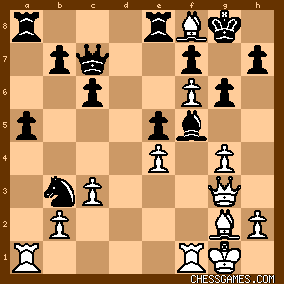
click for larger view
Müller's 21...Rxf8 (followed by 22.Qe3 Qd8 23.Rxf5 Kh8 24.Qh6 Rg8 25.Rf3 Qf8) is NOT the "refutation of Fischer's concept" (Müller) because 22.Qh4!! wins; Black loses material after 22...Qd6 23.Rae1 Nd2 24.Qh6 Qxf6 25.Qxd2 Qd8 26.Qxd8 Raxd8 27.exf5, etc. Instead, 21...Nxa1! leads to an even game: 22.Qh4 Qd8 23.Ba3 Nc2 24.exf5 Qd2 25.fxg6 hxg6 26.g5 Ne3 27.Bh3 Nxf1 28.Qh6 and White's threatened mate-in-one forces Black to take a perpetual check with 28...Qxh2+ 29.Kxf1 Qf4+, etc. |
|
| Jul-04-12 | | CharlesSullivan: After Fox's 19...Kh8, Fischer's 20.Qh4! should have led to a forced win. If 20...Nxb3 (20...gxf5 21.gxf5! and 20...Bxf5 21.exf5! also are winning for White)
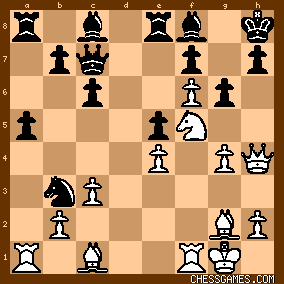
click for larger view
21.Be3!! is the only move that leads to a clearly winning attack; one variation is 21...Nxa1 22.Rf3 h5 ( < After 22...Qd8 White wins brilliantly with 23.Rh3 h5 24.Bf3!! Nc2 25.g5!! Bxf5 26.Bxh5!! >
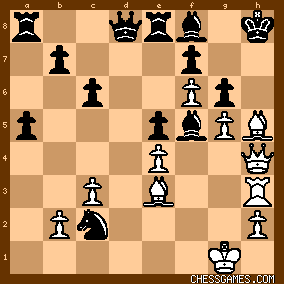
click for larger view
< White has sacrificed rook and knight, but Black has no escape: 26...Kg8 27.exf5 Qd3 28.fxg6 fxg6 29.Bb6 Ne3 30.Rxe3 Qf5 31.Be2! Qb1+ 32.Kf2 Qf5+ 33.Rf3 Qxf3+ 34.Kxf3, etc. > ) 23.Qg5! Qd8
White is down a rook and a pawn, but he has a killer...

click for larger view
24.h3!!! (the only winning move) 24...Nc2 25.gxh5 Nxe3 26.Nxe3 Be6 27.hxg6 fxg6 28.Qxg6 Bg8 29.Rf5 Bh7 30.Rh5 Re7 31.fxe7 Qxe7 32.Ng4 Qg7 33.Qf5 Bc5+ 34.Kh1 Rg8 35.Rxh7+! Qxh7 36.Qxe5+ Qg7 (or 36...Rg7 37.Nf6! Qg6 38.Qb8+ Rg8 39.Nxg8 wins) 37.Qxc5 is a winning position:
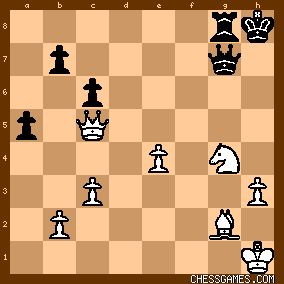
click for larger view |
|
| Jul-04-12 | | CharlesSullivan: As <SereneThought> has pointed out, Fischer could have won with 21.Be3!! Black is lost no matter what he plays, but a stiff resistance is offered by 21...Ne6 22.Rad1 Qc7 23.Rf3
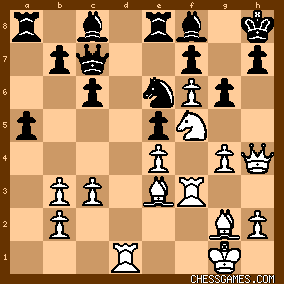
click for larger view
23...Rd8
( < or 23...Nf4 24.Bxf4 Bxf5 25.Bg5! Bxg4 26.Qxg4 wins > ) 24.Rdf1 Nf4 25.Bxf4 exf4 26.Rh3 h5 27.Qg5! Bxf5 28.gxf5 Qe5
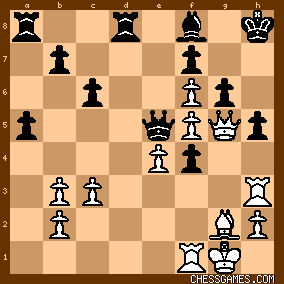
click for larger view
29.Bf3!! Rd3 30.Kh1!
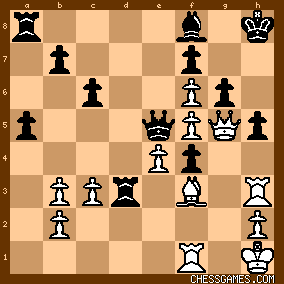
click for larger view
and White's threat of 31.Qxh5+ gxh5 32.Rxh5+ Bh6 33.Rxh6+ Kg8 34.Rg1+ Kf8 35.Rh8# forces Black to enter a losing endgame: 30...Rxf3 31.Rhxf3 Qxe4 32.Qxf4 Qxf4 33.Rxf4 Rd8 34.Re1 Kh7 35.fxg6+ Kxg6 36.Rg1+,

click for larger view
and White can win this. |
|
| Apr-21-14 | | dunamisvpm: Maurice Fox a noted chess olympian was around 58 years old at this time, while Bobby Fischer was around 13. Fyi. GOD bless |
|
| Dec-23-16 | | john.owen: This was the tournament where Fischer started to "get good." He finished one point behind Evans and Lombardy, who tied for first. Tied with Yanofsky among others; I would guess a 2300 plus performance rating. |
|
Dec-23-16
 | | HeMateMe: doesn't 44...Q-f2+ win immediately? |
|
| Dec-23-16 | | parisattack: <john.owen: This was the tournament where Fischer started to "get good." He finished one point behind Evans and Lombardy, who tied for first. Tied with Yanofsky among others; I would guess a 2300 plus performance rating.> 2321/July 1956 is what the ratings chart I put together shows for Fischer. I also show him dropping to 2103 in July/1957 then then 2605 in Sep/1957. I believe in those days ratings were rather 'illiquid' and not terribly reliable on a short-term basis. |
|
Jan-30-18
 | | Richard Taylor: Fischer blundered a pawn he had to play 25. Qf3 when he retains a small advantage. |
|
Jan-30-18
 | | Richard Taylor: Fox was quite old then and he played an excellent game to take advantage of Fischer's weak play (25 Qe3?). |
|
Oct-28-18
 | | maxi: Yeah, Fox missed a mate in two. |
|
| Dec-28-21 | | checkxmate: Maurice's response to the Reti opening (Nf3, Nf6) keeps the game symmetrical, however, I've also seen some people play d5. Maybe in this case keeping it symmetrical would be better. Along with that, playing the King's Indian was probably not the best move. Using Stockfish, I was able to figure out that 2. g3 certainly opens for castling and a fianchetto, but is quite unambitious. Also, when Fox played c3, another good option would have been a4 (again, using Stockfish). |
|
| Feb-17-22 | | jerseybob: <SereneThought: ....Had Fischer played 21.Be3!, he could have won the game by putting pressure on the rook file. For example, 21...NxP, 22.Rf3,NxR, 23.Rh3. If Black takes the knight, White uses the pawns on f5 and f6 as a wall to prevent Black from protecting his king. Just imagine a 13-year-old Fischer conceiving of 17.Nf5!> That's very uhh..serene, and I basically agree. 21..Ne6 looks tougher, but white should still have the edge. The knight sac on f5 is a known theme, especially in the Ruy Lopez, Fischer's specialty. Once Bobby misses his chance, Fox does a great job of coming back. BTW, contrary to one other poster, Fischer was NOT an 1800-strength player at the time of this game. Just before this tourney, he finished the U.S. Open in a tie for 4th-6th places; he was well into the master class. |
|
Feb-17-22
 | | fredthebear: Bill Wall cover's the highlights of Fischer's early days, including results/ratings: https://www.chess.com/article/view/.... "In July, 1956 he played in the 11th U.S. Junior championship in Philadelphia and won his first major event. He won 8 games, lost 1 and drew 1 for 1st place out of 28 players. His rating shot up to 2321. He was the youngest US master at 13 years, 3 months, 29 days. His prize was a typewriter." -- Bill Wall |
|
| Feb-17-22 | | jerseybob: <fredthebear: Bill Wall cover's the highlights of Fischer's early days, including results/ratings: https://www.chess.com/article/view/....> Thanks for the bio and the profile Fred. |
|
Feb-18-22
 | | fredthebear: You're welcome <jerseybob>. I'm a fan of Bobby Fischer the player and Bill Wall, a fellow member here. Bill Wall's chess web page is one of the very best out there: http://billwall.phpwebhosting.com/ |
|
| Feb-18-22 | | Granny O Doul: I was about to suggest that Fischer's 25th move must have been Qd2, but I see that this was pointed out in 2005. Good work, guys. Looking at Bill Wall's page, I read that USCF master at this time began at 2300 (I had seen this info before, though it may have been in the same place). If this is so (as I'd assume), Fischer would have kept that record till...I don't know. |
|
| Feb-20-22 | | jerseybob: <Granny O Doul: .....Looking at Bill Wall's page, I read that USCF master at this time began at 2300...>I just spent a half hour or so scrolling through the Chess Life 1956 annual.
The whole story explaining the downward shift from 2300 to 2200 for the master standard can be found in the May issue, starting with the wording "Hitherto our standards for recognition as a master have been higher than those of many other countries." (etc.) |
|
Feb-20-22
 | | perfidious: As is my wont, I played through this game quickly before reading any kibitzes and wondered why Fischer did not snap off the knight after 26....Qxg4. Turns out that 365chess gives the score as 25.Qd2, which actually makes sense and was noted, long ago. Correction slip to follow. |
|
| Feb-20-22 | | jerseybob: <perfidious:....I wondered why Fischer did not snap off the knight after 26....Qxg4.
Turns out that 365chess gives the score as 25.Qd2, which actually makes sense and was noted, long ago.> Makes a lotta sense. But where do these alternate versions come from in the first place? Maybe when the score sheets were handed in(the carbon copies) the two players had written two versions of move 25? |
|
 |
|
< Earlier Kibitzing · PAGE 2 OF 2 ·
Later Kibitzing> |





